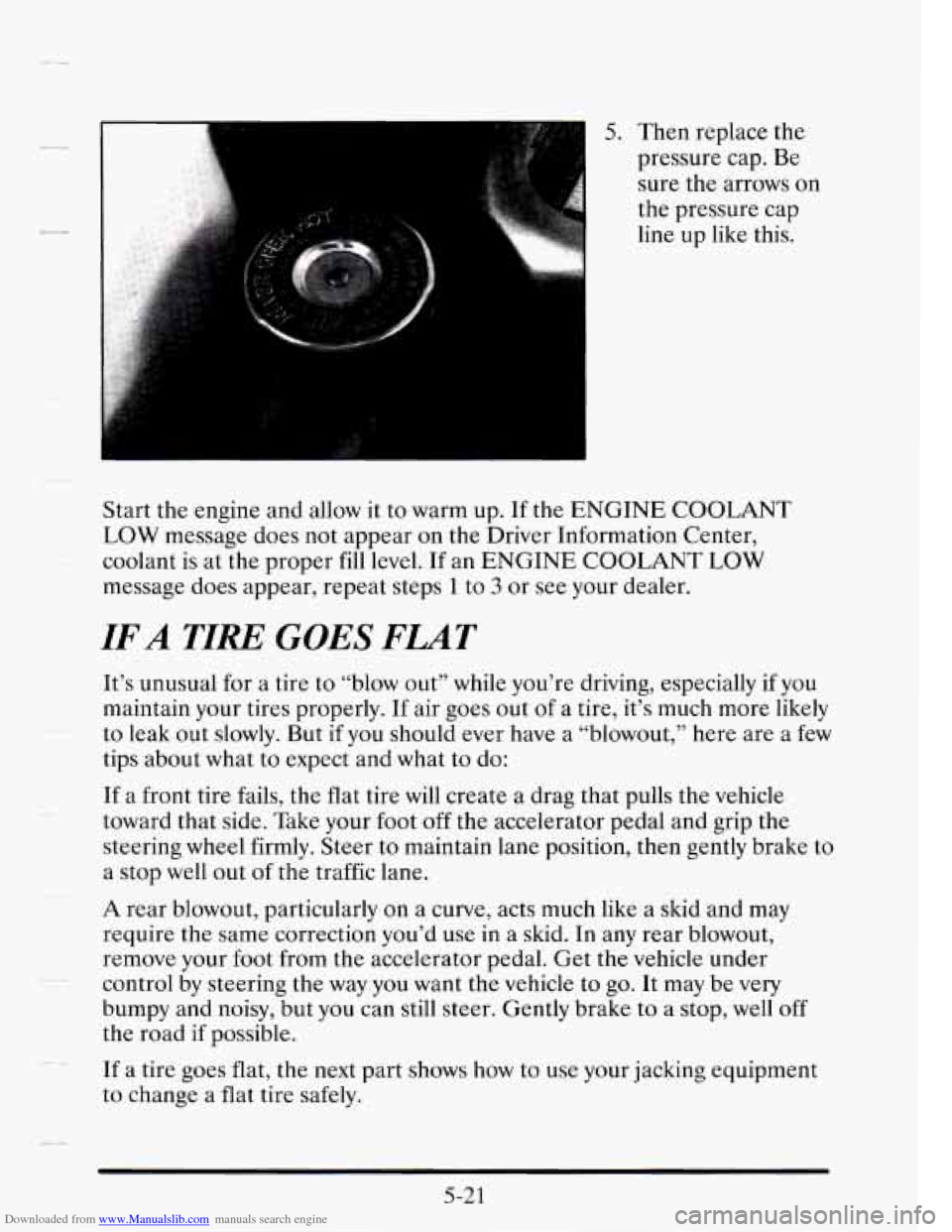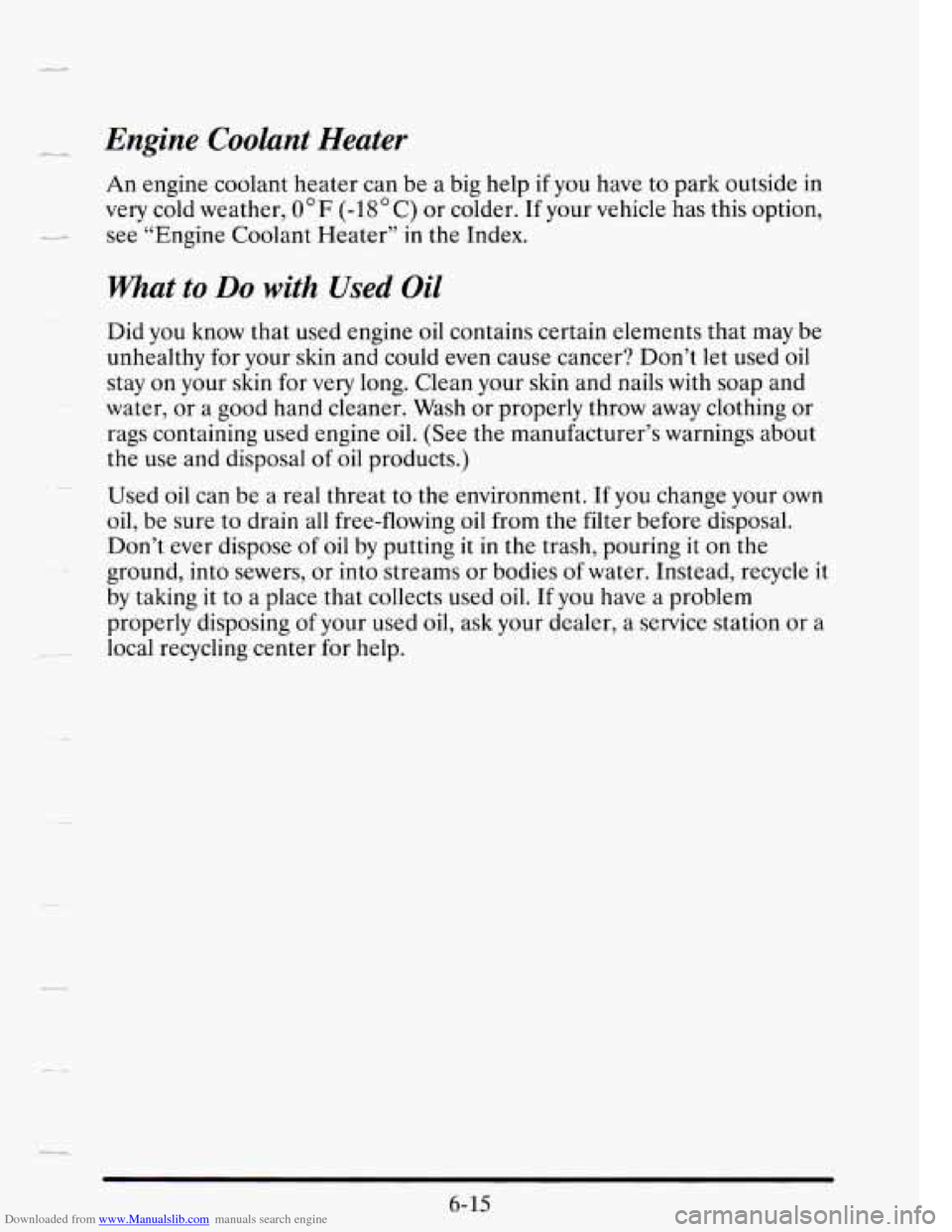Page 257 of 410
Downloaded from www.Manualslib.com manuals search engine I I
NOTICE:
In cold weather, water can freeze and crack the engine, radiator, --
heater core and other parts. So use the recommended coolant.
L
Page 258 of 410
Downloaded from www.Manualslib.com manuals search engine 1. You can remove
the coolant surge
tank pressure
cap when the
cooling system,
including the
coolant surge
tank pressure cap
and upper radiator
hose, is no longer
hot.
Turn the pressure cap slowly to the left until it first stops. (Don't press
down while turning the pressure cap.)
If you hear a hiss, wait for that to stop. A hiss means there is still some
pressure left.
2. Then keep turning
the cap, but now
push down as you
turn it. Remove
the pressure cap.
5-1 9
Page 259 of 410
Downloaded from www.Manualslib.com manuals search engine I 3. Then fill the p_ coolant surge tank
with
the proper
mix, up to the base
of the filler neck.
Zd
- 4. With the coolant
surge tank
pressure cap off,
start
the engine
and
let it run until
you can feel the
upper radiator
hose getting
hot.
Watch out for the
engine fans.
By this time, the coolant level inside the coolant surge tank may be lower. --
If the level is lower, add more of the proper mix to the coolant surge tank
until the level reaches about
two and a half inches (60 mm) below the
base
of the filler neck.
5-20
Page 260 of 410

Downloaded from www.Manualslib.com manuals search engine 5. Then replace the
pressure
cap. Be
sure the arrows on
the pressure cap
line up
like this.
Start the engine and allow
it to warm up. If the ENGINE COOLANT
LOW message does not appear on the Driver Information Center,
coolant
is at the proper fill level. If an ENGINE COOLANT LOW
message does appear, repeat steps 1 to 3 or see your dealer.
IFA TIRE GOES FLAT
It’s unusual for a tire to “blow out” while you’re driving, especially if you
maintain your tires properly.
If air goes out of a tire, it’s much more likely
to leak out slowly. But if you should ever have a “blowout,” here are a few
tips about
what to expect and what to do:
If a front tire fails, the flat tire
will create a drag that pulls the vehicle
toward that side. Take your foot off the accelerator pedal and grip the
steering wheel firmly. Steer to maintain lane position, then gently brake to
a stop well out of the traffic lane.
A rear blowout, particularly on a curve, acts much like a skid and may
require the same correction you’d use in a skid. In any rear blowout,
remove your foot from the accelerator pedal. Get the vehicle under
control by steering the way you want the vehicle
to go. It may be very
bumpy and noisy, but you can still steer. Gently brake to a stop, well off
the road
if possible.
If
a tire goes flat, the next part shows how to use your jacking equipment
to change a flat tire safely.
5-2 1
Page 280 of 410
Downloaded from www.Manualslib.com manuals search engine c
Then go to the front of
the vehicle and lift the
secondary hood release
to open the hood.
Fluid Usage Label
The fluid usage label is a color coded label identifying the various fluids
used in your vehicle.
Colors represented on the label match the lettering or handle color of the
fluid you want to check.
GREEN: Engine Coolant
ORANGE: Power Steering Fluid
0 YELLOW. Engine Oil
RED: Transmission Fluid
WHITE: Brake Fluid
0 BLUE: Washer Fluid
P--+
6-9
Page 286 of 410

Downloaded from www.Manualslib.com manuals search engine - Engine Coolant Heater
An engine coolant heater can be a big help if you have to park outside in
very cold weather,
O°F (-HOC) or colder. If your vehicle has this option,
c- see “Engine Coolant Heater” in the Index.
What to Do with Used Oil
Did you know that used engine oil contains certain elements that may be
unhealthy for your skin and could even cause cancer? Don’t let used oil
stay on your skin
for very long. Clean your skin and nails with soap and
:water, or a good hand cleaner. Wash or properly throw away clothing or
rags containing used engine oil. (See the manufacturer’s warnings about
the use and disposal
of oil products.)
-
-__+
Used oil can be a real threat to the environment. If you change your own
oil, be sure
to drain all free-flowing oil from the filter before disposal.
Don’t ever dispose of oil by putting it in the trash, pouring it on the
ground, into sewers, or
into streams or bodies of water. Instead, recycle it
by taking it to a place that collects used oil. If you have a problem
properly disposing
of your used oil, ask your dealer, a service station or a
local recycling center for help.
6-15
Page 294 of 410
Downloaded from www.Manualslib.com manuals search engine -- ENGINE COOLANT
The following explains your cooling system and how to add coolant when
it
is low. If you have a problem with engine overheating, see “Engine
The proper coolant
for your Cadillac will:
Give freezing protection down to -34OF (-37OC).
m_ Overheating” in the Index.
Give boiling protection up to 262°F (128°C).
Protect against rust and corrosion.
Help keep the proper engine temperature.
Let the warning lights work as they should.
What to Use
Use a mixture of one-half clean water (preferably distilled) and one-half
antifreeze that meets
“GM Specification 1825M,” which won’t damage
aluminum parts. You can also use a recycled coolant conforming to GM
Specification 1825M with a complete coolant flush and refill. Use GM
Engine Coolant Supplement (sealer) with any complete coolant flush and
refill. If you use this mixture,
you don’t need to add anything else.
6-23
Page 295 of 410
Downloaded from www.Manualslib.com manuals search engine I NOTICE: I-
If you use an improper coolant mix, your engine could overheat
and be badly damaged. The repair cost wouldn't be covered by
your warranty.
Too much water in the mix can freeze and crack I-
the engine, radiator, heater core and other parts.
c_
Adding Coolant
Your cooling system when hot is under a lot of pressure. If the ENGINE
COOLANT LOW message should appear on the Driver Information
Center,
you will need to add coolant.
If the ENGINE COOLANT LOW message does not appear, the coolant
is at the proper
fill level.
6-24